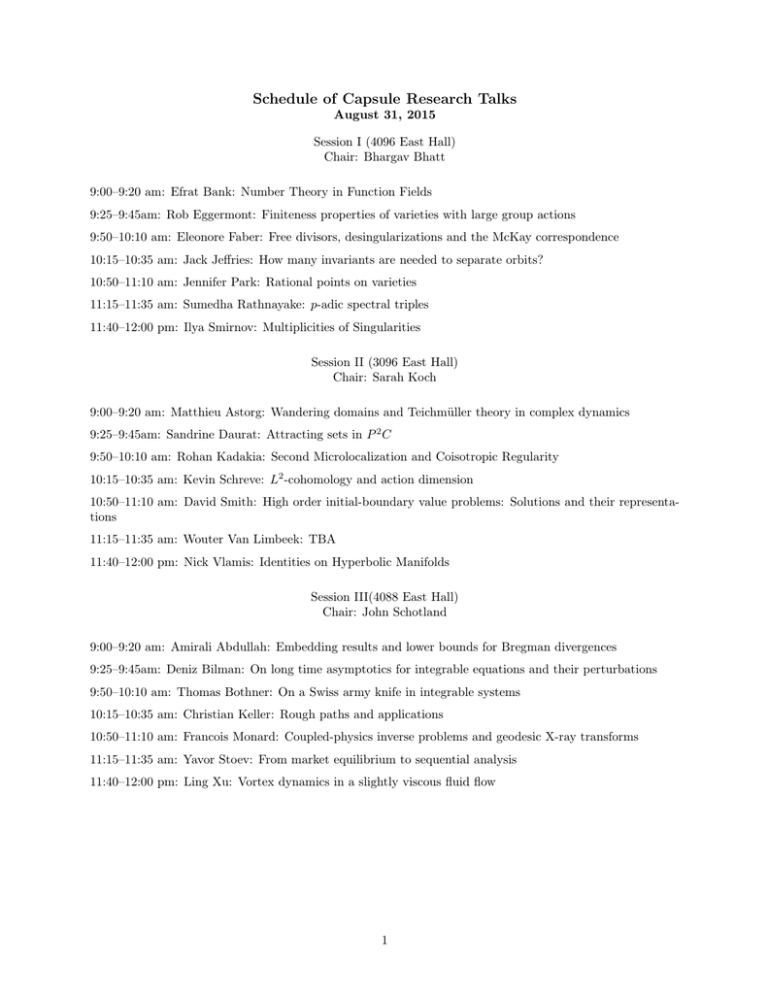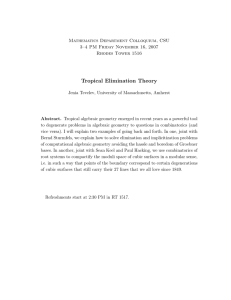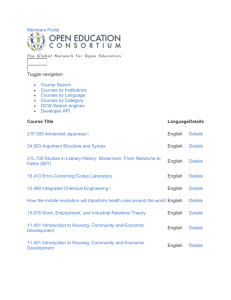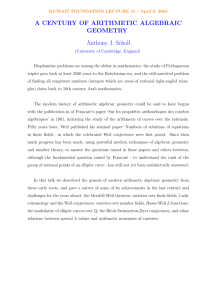Schedule of Capsule Research Talks
advertisement

Schedule of Capsule Research Talks August 31, 2015 Session I (4096 East Hall) Chair: Bhargav Bhatt 9:00–9:20 am: Efrat Bank: Number Theory in Function Fields 9:25–9:45am: Rob Eggermont: Finiteness properties of varieties with large group actions 9:50–10:10 am: Eleonore Faber: Free divisors, desingularizations and the McKay correspondence 10:15–10:35 am: Jack Jeffries: How many invariants are needed to separate orbits? 10:50–11:10 am: Jennifer Park: Rational points on varieties 11:15–11:35 am: Sumedha Rathnayake: p-adic spectral triples 11:40–12:00 pm: Ilya Smirnov: Multiplicities of Singularities Session II (3096 East Hall) Chair: Sarah Koch 9:00–9:20 am: Matthieu Astorg: Wandering domains and Teichmüller theory in complex dynamics 9:25–9:45am: Sandrine Daurat: Attracting sets in P 2 C 9:50–10:10 am: Rohan Kadakia: Second Microlocalization and Coisotropic Regularity 10:15–10:35 am: Kevin Schreve: L2 -cohomology and action dimension 10:50–11:10 am: David Smith: High order initial-boundary value problems: Solutions and their representations 11:15–11:35 am: Wouter Van Limbeek: TBA 11:40–12:00 pm: Nick Vlamis: Identities on Hyperbolic Manifolds Session III(4088 East Hall) Chair: John Schotland 9:00–9:20 am: Amirali Abdullah: Embedding results and lower bounds for Bregman divergences 9:25–9:45am: Deniz Bilman: On long time asymptotics for integrable equations and their perturbations 9:50–10:10 am: Thomas Bothner: On a Swiss army knife in integrable systems 10:15–10:35 am: Christian Keller: Rough paths and applications 10:50–11:10 am: Francois Monard: Coupled-physics inverse problems and geodesic X-ray transforms 11:15–11:35 am: Yavor Stoev: From market equilibrium to sequential analysis 11:40–12:00 pm: Ling Xu: Vortex dynamics in a slightly viscous fluid flow 1 Session IV(3088 East Hall) Chair: David Speyer 9:00–9:20 am: David Fernandez Breton: Set Theory (sometimes) can solve your problem! 9:25–9:45am: Lisa Lamberti: Bases for cluster algebras 9:50–10:10 am: Brendan Pawlowski: Permutation combinatorics in Schubert calculus and representation theory 10:15–10:35 am: Brad Rogers: Some connections between random matrix theory and analytic number theory 10:50–11:10 am: Boaz Slomka: Duality and related problems in convex geometry 11:15–11:35 am: Shira Zerbib: High-dimensional expanders and minimal cycles Abstracts: Amirali Abdullah Embedding results and lower bounds for Bregman divergences The Bregman divergences are a broad class of distance measures having high relevance in information theory, statistics and machine learning applications, and which include the Kullback-Leibler and Euclidean distance as special cases. The algorithmic tractability of these spaces is tightly linked with the underlying geometry, for example the embeddability of point sets into a low dimensional Euclidean space and isoperimetric properties of sets under perturbation. In this talk, I will discuss two of my results exploring the geometry of these spaces in an algorithmic context; namely lower bounds for near neighbor search under Bregman divergences, and upper bounds on dimensionality reduction for large sets of probability distributions. Matthieu Astorg Wandering domains and Teichmüller theory in complex dynamics When iterating holomorphic self maps, one defines the Fatou set as the the largest open set where the iterates form a relatively compact family. It is an open set where the dynamics is best understood. Sullivan famously proved in 1985 that every connected component of the Fatou set is preperiodic for rational maps on CP 1 , notably leading to a complete description of the dynamics in the Fatou set, and introducing tools from Teichmller theory into complex dynamics. On the other hand, we will present recent joint work (with Buff, Dujardin, Peters and Raissy) proving that this is not the case in higher dimension. Efrat Bank: Number Theory in Function Fields. My research focuses on formulating and proving function field analogues of classical number theoretical problems. In this talk I will survey some of these problems; among which are the Hardy-Littlewood n-tuple conjecture, the Goldbach conjecture and conjectures on the number of primes in short interval and in arithmetic progressions. A key role in proving the function field analogues is played by the computation of some Galois groups. Deniz Bilman On long time asymptotics for integrable equations and their perturbations I will talk on obtaining long-time asymptotics for Hamiltonian perturbations of the Toda lattice, numerical inverse scattering, and some interesting problems which arise in these studies. Thomas Bothner On a Swiss army knife in integrable systems Seemingly unrelated questions in statistical mechanics can in fact be placed on common ground: they are related to Riemann-Hilbert problems (RHPs). These problems provide a common framework for aspects of the finite model and open the door to a rigorous analysis of the thermodynamical limit. We shall briefly sketch some known results in this field focusing on random matrix theory, the theory of exactly solvable lattice models and nonlinear wave equations. Sandrine Daurat Attracting sets in P 2 C This talk is a discussion on the geometry and ergodic proprieties of attracting sets for endomorphisms of P 2 C based on visual examples. 2 Rob Eggermont Finiteness properties of varieties with large group actions Finding equations for and testing membership of a variety are two important problems in algebraic geometry. Generally, the larger the dimension of a given affine space, the more difficult it is to solve these problems for varieties in said space. In an infinite-dimensional affine space, one may need infinitely many equations to define a given variety. However, there are many cases in which one is interested in discrete families of varieties for which the dimension can be arbitrarily large. In this talk, we will describe some finiteness properties that still apply for families of varieties with many symmetries. In particular, in infinite dimension, certain varieties can be defined with finitely many types of equations. David Fernandez Breton Set Theory (sometimes) can solve your problem! Set Theory is the branch of Mathematical Logic that deals with a particular axiom system, namely ZFC (Zermelo-Fraenkel axioms plus the axiom of Choice), and that studies (roughly speaking) what kinds of mathematical statements are undecidable (this is, cannot be proved nor disproved) under these axioms. The first example of such a statement is the Continuum Hypothesis. Since the ZFC axioms are commonly thought to be the axioms of “all of mathematics,” this means that there is potential for finding undecidable statements in every area of mathematics, and this program has been steadily brought to reality by set theorists in the past few decades. Numerous open problems, from areas such as analysis, algebra, general topology and, more recently, from the study of C ∗ -algebras and operator algebras, as well as the geometry of Banach spaces, have been either shown undecidable by set theorists or solved by the use of set-theoretic methods. Hence I plan to give an overview of these results, in the hopes of convincing some people from outside of Logic that the use of set-theoretic methods (or the collaboration with a set theorist!) are certainly worth a try. Eleonore Faber Free divisors, desingularizations and the McKay correspondence In this talk I will review some of my current research interests: free divisors are hypersurfaces, which are singular in codimension one but have a rich algebraic structure. One is interested in desingularizations of these divisors, especially in existence and constructions of non-commutative resolutions of singularities. In the particular case of discriminants of a finite complex reflection group G we were able to construct a non-commutative resolution, as quotient of the skew group ring of G. This yields a McKay corresondence for reflections groups, linking algebra, geometry and representation theory and is not yet fully understood. Jack Jeffries How many invariants are needed to separate orbits? The study of separating invariants is a recent trend in invariant theory. For a finite group acting linearly on a vector space, a separating set is a set of invariants that, as functions, suffices to distinguish the orbits of the group action. In many ways, these behave better than generating sets for the invariant ring. We will discuss some results and questions related to this notion. Rohan Kadakia Second Microlocalization and Coisotropic Regularity Second microlocalization is more refined (micro-)localization near a submanifold of T ∗ X. In this talk, I will clarify what I mean by more refined, mainly by drawing pictures and making analogies. I will start by discussing what it means to blow up a submanifold of the cotangent bundle, in semiclassical analysis. Specifically, I have studied coisotropic submanifolds. I will proceed to define these and the notion of coisotropic regularity of a distribution. Finally, I will describe how second microlocalization gives an additional layer of information about distributions, e.g. Laplace eigenfunctions. Christian Keller Rough paths and applications I will motivate the theory of rough paths introduced by Terry Lyons, present basic notions of the theory, and point out applications for stochastic PDEs. Lisa Lambert Bases for cluster algebras Due to the connections between cluster algebras and dual canonical bases in algebraic groups, the construction of additive bases in cluster algebras is a central problem. In this talk we will review some aspects of this theory, focusing on the cluster algebras given by the homogeneous coordinate ring of Grassmannians. 3 Francois Monard Coupled-physics inverse problems and geodesic X-ray transforms My main research interests lie in the field of inverse problems, more recently the two topics mentioned in the title. In this presentation, I will introduce each topic and motivate some questions related to each topic: - Coupled-physics (or hybrid) inverse problems is a class of inverse problems whose primary purpose is to model future medical imaging modalities with both high contrast and high resolution. The models involved require analyzing parameter reconstruction problems in certain PDEs from knowledge of internal functionals, for which I will describe an inversion approach. - Problems in integral geometry often consist in reconstructing a function on a manifold from knowledge of its integral over certain submanifolds. An example of such an integral transform is the geodesic x-ray transform, i.e. the collection of integrals of a given function (or tensor field) over all geodesics of a given manifold (e.g., the Radon transform in the 2D Euclidean setting). Such a transform can be generalized to other types of flows (magnetic/thermostat), augmented with a weight (attenuated transform) or even made ”non-abelian” by considering vector-valued integrands with a matrix-valued attenuation. The typical inverse problems-related questions (injectivity, stability, explicit reconstruction, numerics) abound on the theme and strongly depend on spatial dimension and geometric properties of the underlying manifold. Jennifer Park Rational points on varieties Finding rational points on varieties is a long-standing problem that benefits greatly from various perspectives, from logic to algebraic to analytic to geometric. In this talk, I will outline some of the results from these various perspectives, and discuss some of the unresolved problems in this area. Brendan Pawlowski Permutation combinatorics in Schubert calculus and representation theory The representation theory of the symmetric or general linear groups, the ring of symmetric functions, and the cohomology of Grassmannians (or flag varieties) are all closely related. I will discuss these relationships and some of the combinatorics that arises. In particular, as a guiding combinatorial example I will take the study of reduced words for permutations— that is, minimal-length factorizations of a permutation into adjacent transpositions (i i + 1). Sumedha Rathnayake p-adic spectral triples In their groundbreaking paper in 1882 “Theory of algebraic functions of one variable,” Dedekind and Weber explored the analogies between algebraic number theory and algebraic geometry via the analogies between algebraic number fields and algebraic function fields. The noncommutative analogue of this story is still at a very early stage. In an attempt to understand the parallelisms between noncommutative Riemann surfaces and the noncommutative theory of algebraic number fields, as a first step we have studied algebraic extensions of the field of p-adic numbers from the point of view of noncommutative geometry. This work entails several classical fields such as number theory and operator theory. Brad Rogers Some connections between random matrix theory and analytic number theory This talk will attempt to give an overview of some classical results in random matrix theory and explain a few of the roles random matrix theory has played in connection with analytic number theory. If there is sufficient time, we will talk about a recent application of this circle of ideas to studying the statistical properties of divisor counts. The talk will not assume any specialist background. Kevin Schreve L2 -cohomology and action dimension The action dimension of a group Γ, actdim(Γ), is the minimal dimension of a contractible manifold that Γ acts on properly discontinuously. The action dimension conjecture states that the L2 -Betti numbers of Γ vanish above actdim(Γ)/2. I’ll give a short introduction to L2 -homology, then talk about some strategies to prove the action dimension conjecture. Boaz Slomka Duality and related problems in convex geometry Duality plays an important role in various areas of mathematics. In the context of convex geometry, one form of duality is given by the well-known polarity transform. We will discuss some of its properties, as well as related results and problems. One particular problem involves covering numbers, whose correspondence to separation numbers makes another form of duality which we will discuss in this context. 4 Ilya Smirnov: Multiplicities of Singularities Hilbert-Samuel multiplicity is a classical invariant that extends the notion of multiplicity at a point from curves to arbitrary varieties. In positive characteristic, one can use the Frobenius endomorphism to define Hilbert-Kunz multiplicity, a more exotic invariant, that, for example, needs not to be an integer. In my talk, I will try to explain how these multiplicities can be used to measure singularities. David Smith High order initial-boundary value problems: Solutions and their representations We study initial-boundary value problems for linear evolution equations of arbitrary order, on a finite or semi-infinite domain, with arbitrary boundary conditions, using the Unified Transform Method of Fokas. The solution obtained is expressed as an integral, which represents a new kind of spectral transform. We compare the new solution representation, with classical Fourier transform solution representations. In doing so, we discover a new species of spectral object. Yavor Stoev From market equilibrium to sequential analysis A general overview of mathematical finance is presented, leading to the concept of equilibrium. In view of applying the mathematical models of financial markets in practice, we give an introduction to the theory of sequential analysis. Along the way the needed mathematical tools are discussed. Wouter Van Limbeek TBA Nick Vlamis Identities on Hyperbolic Manifolds In the past 25 years, several remarkable identities on hyperbolic manifolds have been discovered by McShane, Basmajian, Bridgeman-Kahn, and Luo-Tan. By an identity, we mean an explicit relationship between spectral data of a hyperbolic manifold (e.g. lengths of a class of curves or arcs) and a piece of geometric data (e.g. the volume of the manifold or the area of its boundary). I will give a brief history/overview of these identities and present a unifying idea behind them described by Tan. Ling Xu Vortex dynamics in a slightly viscous fluid flow My research is mainly focus on vortex dynamics and the development of suitable methods in such systems. During the summer, I am working two projects. One is to develop a viscous vortex method for slightly viscous flow. The other one is to investigate the role of vorticity in fish swimming in a school. I am going to talk briefly about my previous work and how they are related to the current projects. Shira Zerbib High-dimensional expanders, minimal cycles, and d-intervals I will discuss shortly a couple of related problems. The first one concerns high-dimensional expanders: following Gromov’s work on the topological overlap property, we study the co-boundary expansion of spherical buildings. We improve a result by Lubotzky, Meshulam and Mozes on the expansion of these complexes. The second problem concerns minimal cycles in Lusztig-Dupont Modules: we give a lower bound on the minimal support of a non-zero cycle in the homology of spherical buildings with certain local coefficient systems introduced by Lusztig and Dupont. Based on joint works with Roy Meshulam. 5


